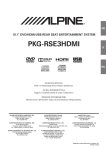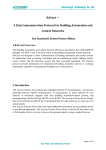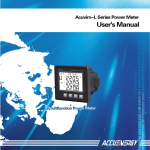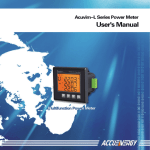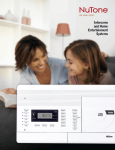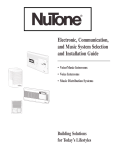Download Modbus Map - Meters USA
Transcript
Chapter 5 Function and Software Introducing Modbus Protocol Format of the communication Data Address Table and Application Details of Acuvim II 73 This chapter will mainly discuss how to handle the meter via the communication port using software. To master this chapter, you should be familiar with Modbus and have read other chapters of this manual, and you have generously mastered the function and application of this product. This chapter includes: Modbus protocol, format of communication and data address table and Acuvim II application details. 5.1 Introducing Modbus Protocol The Modbus RTU protocol is used for communication in Acuvim II. The data format and error check met hods are defined in Modbus protocol. The half duplex query and respond mode is adopt ed in Modbus protocol. There is only one master device in the communication net. The others are slave devices, waiting for the query of the master. Transmission mode which is compatible with Modbus RTU Mode*. Coding System Start bit 8-bit binary 1 Data bits Parity Stop bit 8 no parity 1 Error checking CRC check Framing Address 8-Bits Function 8-Bits Data N×8-Bits Table5.1 Data Frame Format 74 Check 16-Bits Address Field The address field of a message frame contains eight bits. Valid slave device addresses are in the range of 0~247 decimal. A master addresses When the slave sends its response, it places its own address in this address field of the response to let the master know which slave is responding. Function Field The function code field of a message frame contains eight bits. Valid codes are in the range of 1~255 decimal. When a message is sent from a of action to perform. Code Meaning Action 01 Read Relay Output Status Obtain current status of Relay Output 02 Read Digital Input(DI) Status Obtain current status of Digital Input 03 Read Data Obtain current binary value in one or more registers 05 Control Relay Output Force Relay to a state of on or off 16 Press Multiple-Register consecutive Multiple-Registers Table5.2 Function Code Data Field range of 00 to FF hexadecimal. The data field of messages sent from a master to slave devices contains additional information which the slave must use to take the action defined by the function code. This can include items like discrete and register addresses, the quantity of 75 items to be handled, and the count of actual data bytes in the field. For example, if the master requests a slave to read a group of holding and how many registers are to be read. If the master writes to a group registers. contains the data requested. If an error occurs, the field contains an exception code that the master application can use to determine the next action to be taken. The data field can be nonexistent (of zero length) in certain kinds of messages. Error Check Field Messages include an error’s checking field that is based on a Cyclical the entire message. It is applied regardless of any parity check method bytes, containing a 16 bit binary value. The CRC value is calculated by the transmitting device, which appends the CRC to the message. The receiving device recalculates a CRC during receipt of the message, and compares the calculated value to the actual value it received in the begins of applying successive 8-bit bytes of the message to the current contents of the register. Only the eight bits of data in each character are used for generating the CRC. Start and stop bits, and the parity bit, do 76 not apply to the CRC. During generation of the CRC, each 8-bit character is exclusive ORed with the register contents. Then the result is shifted in value. If the LSB was a 0, no exclusive OR takes place. This process is repeated until eight shifts have been performed. After the last (eighth) shift, the next 8-bit byte is exclusive ORed with the register current value, and the process repeats for eight more shifts as described above. The final contents of the register, after all the bytes of the message have been applied, is the CRC value. When the CRC is appended to the byte. 5.2 Format of Communication Explanation of frame Addr Fun 06H 03H Data start Data start Data #of reg hi reg lo regs hi 00H 00H 00H Data #of regs lo 21H CRC 16 Hi 84H CRC 16 Lo 65H Table 5.3 Explanation of frame In table5.3, the meaning of each abbreviated word is, Addr: address of slave device Fun: function code Data start reg hi: start register address high byte Data start reg lo: start register address low byte Data #of reg hi: number of register high byte Data #of reg lo: number of register low byte CRC16 Hi: CRC high byte CRC16 Lo: CRC low byte 77 1. Read Status of Relay Function Code 01 This function code is used to read status of relay in Acuvim II. 1=On 0=Off Relay1’s address is 0x0000, Relay2’s address is 0x0001, and so on. The following query is to read relay status of Acuvim II with the address of 17. Query Addr Fun 11H 01H Relay start Relay start Relay #of reg hi reg lo regs hi 00H 00H 00H Relay #of regs lo 02H CRC 16 Hi BFH CRC 16 Lo 5BH Table 5.4 Read the status of Relay1 and Relay2 Query Message Response The Acuvim II response includes the Acuvim II address, function code, quantity of data byte, the data, and error checking. An example response to read the status of Relay1 and Relay2 is shown as Table5.5. The status of Relay1 and Relay2 are responding to the last 2 bits of the data. Relay1: bit0 Relay2: bit1 Address 11H Function code 01H Byte count 01H Data 02H CRC high D4H CRC low 89H Table 5.5 Relay status responds The content of the data is: 7 0 MSB 6 0 5 0 4 0 3 0 Relay1 = OFF ( LSB ), Relay2=ON (Left to LSB ) 78 2 0 1 1 0 0 LSB 2. Read the Status of DI Function Code 02 1=On 0=Off DI1’s address is 0x0000, DI2’s address is 0x0001, and so on. The following query is to read the Status of 4 DIs of Acuvim II with the address of 17. Query Addr Fun 11H 02H DI start addr hi 00H DI start addr lo 00H DI num lo 04H DI num hi 00H CRC 16 Hi 7BH CRC 16 Lo 59H Table 5.6 Read 4 DIs Query Message Response The Acuvim II response includes the Acuvim II address, function code, quantity of data characters, the data characters, and error checking. An example response to read the status of 4 DIs are shown as Table 5.7. The status of 4 DIs are responding to the last 4 bits of the data. DI1: bit0; DI2: bit1; DI3: bit2; DI4: bit3. Address 11H Function code 02H Byte count 01H Data 03H CRC high E5H CRC low 49H Table 5.7 Read Status of DI The content of the data is: 7 0 6 0 5 0 4 0 MSB 3 0 2 0 1 1 0 1 LSB DI1=On, DI2=On, DI3=Off, DI4=Off. 79 3. Read Data (Function Code 03) Query This function allows the master to obtain the measurement results of Acuvim II. Table5.8 is an example to read the 3 measured data (F, V1 and V2) from slave device number 17, the data address of F is 4000H, 4001H; V1's address is 4002H, 4003, and V2's address is 4004H, 4005H. Addr Fun 11H 03H D a t a s t a r t D a t a s t a r t D a t a # o f Data #of CRC 16 addr hi addr lo regs hi regs lo regs Hi 40H 00H 00H 06H D2H CRC 16 regs Lo 98H Table 5.8 Read F, V1, V2 Query Message Response The Acuvim II response includes the Acuvim II address, function code, quantity of data byte, data, and error checking. An example response to read F, V1 and V2 (F=42480000H (50.00Hz), V1=42C7CCCDH (99.9V), V2=42C83333H (100.1V)) is shown: Byte Data1 Data1 Data 2 Data2 Data3 Data3 Data4 Data4 count hi Lo hi lo hi lo hi lo 3H 0CH 42H 48H 00H 00H 42H C7H CCH CDH Addr Fun 11H Data5 hi 42H Data5 Lo C8H Data 6 hi 33H Data6 lo 33H CRC16 hi CAH CRC16 lo 7FH Table 5.9 Read F, V1 and V2 Message 4. Control Relay (Function Code 05) Query This message forces a single relay either on or off. Any relay that exists within the Acuvim II can be forced to be either status (on or off). The 80 data value FF00H will set the relay on and the value 0000H will turn it off; all other values are illegal and will not affect that relay. The example below is a request to the Acuvim II with the address of 17 to turn on Relay1. Addr Fun 11H 05H DO addr hi 00H DO addr lo 00H Value hi FFH Value lo 00H CRC 16 Hi 8EH CRC 16 Lo AAH Table5.10 Control Relay Query Message Response The normal response to the command request is to retransmit the message as received after the relay status has been altered. Addr Fun 11H 05H Relay addr Relay addr hi lo 00H 00H Value hi FFH Value lo 00H CRC Hi 8EH CRC Lo AAH Table5.11 Control Relay Response Message 5. Preset / Reset Multi-Register (Function Code 16) Query Function 16 allows the user to modify the contents of a Multi-Register. Some Registers of Acuvim II can have their contents changed by this message. The example below is a request to an Acuvim II with the address of 17 to preset Ep_imp as "17807783.3KWh", while its HEX value is 0A9D4089H. Ep_imp data address is 0x4048 and 0x4049. Addr Fun 11H 10H Data start reg hi 40H Data start reg lo 48H Data #of reg hi 00H Data #of reg lo 02H Byte Count 04H 81 Value hi 0AH Value Lo 9DH Value hi 40H Value lo 89H CRC hi F1H CRC lo 6AH Table5.12 Preset Multi-Register Query Message Response The normal response to a preset Multi-Register request includes the Acuvim II address, function code, data start register, the number of registers, and error checking. Addr 11H Fun 10H Data start Data start reg hi reg lo 40H 48H Data #of reg hi 00H Data #of Reg lo 02H CRC16 hi D6H CRC16 lo 8EH Table5.13 Preset Multi-Register Response Message 5.3 Data Address Table and Application Details of Acuvim II There are several rules to follow in using the meter: 1. Data type: “bit” refers to binary. “word” refers to 16-bit unsigned integer using one data address and 2 bytes of memory, it varies from 0 to 65535. “int” refers to 16-bit integer using one data address and 2 bytes of memory, it varies from -32768 to32767. “dword” refers to 32-bit unsigned integer using two data addresses and 4 bytes of memory with high word at the front and low word at the end, it varies from 0 to 4294967295. Rx=high word *65536+low word. of memory, it varies from -1.175494E-38 to 3.402823E+38. 82 2. Relationship between communication value and numerical value. The numerical value may not the communication value, it is important to notice this. The following table shows how they respond to each other. Parameters Relationship Numerical value equals to System parameters communication value Run time T=Rx/100 Numerical value equals to Clock communication value Energy(primary) Ep=Rx/10 Reactive energy(primary) Eq=Rx/10 Apparent energy(primary) Es=Rx/10 Energy(secondary) Ep=Rx/1000 Reactive energy Eq=Rx/1000 (secondary) Apparent energy Es=Rx/1000 (secondary) frequency F=Rx/100 Voltage U=Rx X(PT1/PT2)/10 Current I=Rx X(CT1/CT2)/1000 Power, demand P=Rx X(PT1/PT2)X(CT1/CT2) Q =Rx X(PT1/PT2)X(C T1/ Reactive power, demand CT2) Apparent power, demand S=Rx X(PT1/PT2)X(CT1/CT2) Power factor PF=Rx/1000 Unbalance factor Unbl=(Rx/1000)X100 THD THD=(Rx/10000) X 100% Harmonics HDn=(Rx/10000) X 100% Total odd HD HDo=(Rx/10000) X 100% Total even HD HDe=(Rx/10000) X 100% Crest factor CF=Rx/1000 K factor KF=Rx/10 Unit Format code No unit F1 Hour Unit of time kWh kvarh KVA KWh F2 Kvarh F8 F3 F4 F5 F6 F7 KVA F9 Hz V A W F10 F11 F12 F13 var F14 VA No unit No unit No unit No unit No unit No unit No unit No unit F15 F16 F17 F18 F19 F20 F21 F22 F23 83 THFF Phase angle temperature THFF=(Rx/10000) X 100% Phase angle=Rx/10 Temperature= Rx/10 No unit Degree °C F24 F25 F26 Important Note: Regions from “System parameters settings” to “AO transforming parameter settings” are the regions that can be set and 1. Using function code 10H, one communication order can only modify contents in one region, such as “System parameters settings”, ”System status parameter”, “Date and Time table”, “Over-range alarming-Global settings”, “Over-range alarming-Single settings”, “I/O Modules settings”. It can not be accomplished in one communication order to modify contents in both of two or more regions above. 2. Using function code 03H, there is no such rules described above. System parameter setting System parameters determine how the meter works. User should understand them clearly by referring to chapter 3 and chapter 4. Function code: 03H for reading, 10H for preset ting. Data t ype: wor d. Format code: F1. Address 1000H 1001H 1002H 1003H 1004H 1005H 1006H 84 Parameter Default Range Pass Word 0 0~9999 Communication Address 1 1~247 Baud Rate 19200 600~38400 Voltage Input Wiring Type 0 0:3LN,1:2LN,2:2LL,3:3LL Current Input Wiring 0 0:3CT,1:1CT,2:2CT Type PT1 (High 16 bit) 0 50.0~500000.0 PT1 (Low 16 bit) 220.0 R/W R/W R/W R/W R/W R/W R/W 1007H 1008H 1009H 100aH 100bH 100cH PT2 CT1 CT2 kWh pulse constant kvarh pulse constant LCD Back light Time 220.0 5 5 1 1 1 100dH Demand Slid Window Time 15 100fH 1010H 1011H Demand calculating mode Clear demand memory Max/Min clear Run time clear 1012H Current I1 direction 0 1013H Current I2 direction 0 1014H Current I3 direction 0 1015H 1016H VAR/PF convention Energy clear 0 0 1017H Energy calculating mode 1 100eH 1 0 0x55 0 1019H Reactive power measuring mode Energy display mode 101aH Ethernet Module reset 0 101bH SOE enable 0 1018H 50.0~400.0 1~50000 1,5 1~6000 1~6000 0-120 R/W R/W R/W R/W R/W R/W 1~30 R/W 1:sliding window 2:thermal Only 1 works Only 0x0A works Only 1 works 0: Positive 1: Negative 0: Positive 1: Negative 0: Positive 1: Negative 0:IEC,1:IEEE Only 1 works 0:fundamental 1:full-wave R/W R/W R/W R/W R/W R/W R/W R/W R/W R/W 0 0:real,1:general R/W 0 0:primary 1:secondary 0:none, 1:reset, 2:load default and reset 0:none; 1:AXM-IO11; 2:AXM-IO21; 3:AXM-IO31; 4:AXM-IO12; 5:AXM-IO22; 6:AXM-IO32; R/W R/W R/W 85 101cH Pulse counter clear 0 101dH Basic parameter mode 0 0:none 1:AXM-IO11; 2:AXM-IO21; 3:AXM-IO31; 4:AXM-IO12; 5:AXM-IO22; 6:AXM-IO32; 0:secondary; 1:primary R/W R/W System status parameter “System status” indicates what events happened in the meter, what kinds Flags should be cleared after being read by the controller, otherwise new data will not be stored properly. Function code: 03H for reading, 10H for writing. Data type: word. Address 101eH~102dH 102eH Parameter Recording pointer bj_st0-15 86 new data Property R/W Bit0:new alarming or not Bit1 new SOE or not R F1 0~15 R F1 0~19 F2 0~999999999 R R R Bit0: AXM-IO11; Bit1:AXM-IO12; B it 2:A XM -I O 21 ; B it 3: A XM -I O 22 ; B it 4:A XM IO31; Bit5:AXM-IO32; 0:disconnected 1:connected Expanded IO Modules connecting status 1037H Temperature 1038H~103fH Reserved Range 1 System status 102fH~ 1031H Reserved Alarming group 1032H number 1033H SOE group number 1034H Run time (high) 1035H Run time (low) 1036H Format code F26 R R Please refer to chapter 3 and chapter 4 for more details about parameter settings. Date and Time table Function code: 03H for reading, 10H for presetting. Address 1040H 1041H 1042H 1043H 1044H 1045H Parameter Year Month Day Hour minute second Format code F3 F3 F3 F3 F3 F3 Range 2000-2099 1-12 1-31 0-23 0-59 0-59 Property R/W R/W R/W R/W R/W R/W Over-range alarming setting This setting consists of global settings and single settings. The global settings contain settings of all global variables. There are 16 groups of records with the same format. Function code: 03H for reading, 10H for writing. Please refer to chapter 4 for more details. Global settings Address 1046H 1047H 1048H Parameter Global alarming enable Alarming channel enable setting Range 0:disable;1:enable 0:disable;1:enable 0~65535 Bit0:channel 1 1:enable; 0:disable Bit1: channel 2 …… Bit15: channel 16 Property R/W R/W R/W 87 0~255 1049H Logical “And ” between alarming setting 104aH Alarming output to DO1 setting 104bH 104cH 104dH 1:enable;0:disable Bit1: second logic switch …… Bit7: eighth logic switch 0~65535 Bit0: channel 1 output 1:enable;0:disable Bit1: channel 2 output …… Bit15: channel 16 output 0~65535 The same as previous 0~65535 The same as previous 0~65535 The same as previous Alarming output to DO2 setting Alarming output to DO3 setting Alarming output to DO4 setting R/W R/W R/W R/W R/W Single settings Address 104eH 104fH 1050H 1051H 1052H 1053H~ 109dH 88 Parameter First group: parameter code First group: comparison mode First group: setting value First group: delay First group: output to relay 2nd to 16th group Format code F1 F1 F10~F18 F1 F1 Range 0~44 1 : m o r e , 2 : equal,3:less Related with parameters 0~3000(*10ms) 0:none,1-8: related relay Same as the first group Property R/W R/W R/W R/W R/W R/W Alarming parameter code table Setting Alarming value object 0 frequency 3 Vc 6 Ubc Line current 9 of phase A Average line 12 current Power of 15 phase B Reactive 18 power of phase A Reactive 21 power of all Apparent 24 power of phase C 27 PF of B Voltage 30 unbalance factor U_unbl THD_V1(V1 33 or V12) Average 36 THD_V Alarming object 1 4 7 10 Va Average phase voltage Uca Line current of phase B Alarming object 2 5 8 11 Vb Uab Average line voltage Line current of phase C 13 Neutral current 14 Power of phase A 16 Power of phase C 17 Power of all 19 Reactive power of phase B 20 Reactive power of phase C 22 Apparent power of phase A 23 Apparent power of phase B 25 Apparent power of all 26 PF of A 28 PF of C 29 PF 31 Current unbalance factor I_unbl 32 Load characteristic(R/ L/C) 34 THD_V2(V2 or V31) 35 THD_V3(V3 or V23) 37 THD_I1 38 THD_ I2 41 AI1 sampling value 44 AI4 sampling value 39 THD_ I3 40 Average THD_I 42 AI2 sampling value 43 AI3 sampling value 89 I/O Modules settings These settings are for some extended I/O modules, if there is no any extended I/O modules, all the settings are of no use. Please check the I/O connecting status before you do any settings. Function code: 03H for reading, 10H for writing. Please refer to <<User’s manual of extended I/O Modules>>for more details. AXM-IO11 Address Parameter Default 109eH DI1-6 type 0 109fH DI pulse constant Working mode of relay 1 10a0H and 2 Output mode of relay 1 10a1H and 2 10a2H Pulse width 0 0 Range Bit0-DI1, Bit1-DI2 Bit2-DI3, Bit3-DI4 Bit4-DI5, Bit5-DI6 0-DI,1-pulse counter 1~65535 0-control output 1-alarming output Property R/W R/W R/W 0 0-latch, 1-momentary R/W 50 50-3000ms R/W AXM-IO21 Address 90 Parameter Default 10a3H DI7-10 type 0 10a4H DI pulse constant 0 10a5H Working mode of DO 0 10a6H DO pulse width 20 10a7H DO1 output 0 Range Bit0-DI7, Bit1-DI8 Bit2-DI9, Bit3-DI10 0-DI,1-pulse counter 1~65535 0-pulse output 1-alarming output 20-1000ms 0-none 1-consumption power 2-gererating power 3-absorption reactive power 4-generating reactive power Property R/W R/W R/W R/W R/W 10a8H DO2 output 0 10a9H AO1,2 type 0 Same as above 0:0-20mA, 1:4-20mA,2:0-5V, 3:1-5V R/W R/W AXM-IO31 Address Parameter Default Range Bit0-DI11,Bit1-DI12, Bit2-DI13, Bit3-DI14 0-DI,1-pulse counter 1-65535 0-control output 1-alarming output Property 10aaH DI11-14 type 0 10abH DI pulse constant Wo r k i n g m o d e o f 10acH relay 3 and 4 Output mode of 10adH relay 3 and 4 10aeH Pulse width 0 0 0-latch, 1-momentary R/W 50 R/W 10afH 0 50-3000ms 0:0-20mA, 1:4-20mA 2:0-5V, 3:1-5V AI1,2 type 0 R/W R/W R/W R/W AXM-IO12 Address Parameter Default Range Bit0-DI15,Bit1-DI16, Bit2-DI17,Bit3-DI18, Bit4-DI19, Bit5-DI20 0-DI,1-pulse counter 1-65535 0-control output 1-alarming output Property 0 0-latch,1-momentary R/W 50 50-3000ms R/W 10b0H DI15-20 type 0 10b1H DI pulse constant (high) Working mode of relay 5 and 6 Output mode of relay 5 and 6 Pulse width 0 10b2H 10b3H 10b4H 0 R/W R/W R/W 91 AXM-IO22 Address Parameter Default 10b5H DI21-24 type 0 10b6H 0 10b8H DI pulse constant Wo r k i n g m o d e o f DO3,4 DO Pulse width 20 10b9H DO3 output 0 10baH DO4 output 0 10bbH AO3,4 type 0 10b7H 0 Range Bit0-DI21,Bit1-DI22, Bit2-DI23, Bit3-DI24 0-DI,1-pulse counter 1-65535 0-pulse output 1-alarming output 20-1000ms 0-none 1-consumption power 2-gererating power 3-absorption reactive power 4-generating reactive power Same as above 0:0-20mA, 1:4-20mA, 2:0-5V, 3:1-5V Property R/W R/W R/W R/W R/W R/W R/W AXM-IO32 Address Default Range Bit0-DI25, Bit1-DI26 Bit2-DI27, Bit3-DI28 0-DI, 1-pulse counter 1-65535 0-control output 1-alarming output Property 10bcH DI25-28 type 0 10bdH 0 0 0-latch, 1-momentary R/W 10c0H DI pulse constant Wo r k i n g m o d e o f relay 7 and 8 Output mode of relay 7 and 8 Pulse width 50 R/W 10c1H AI3,4 type 0 50-3000 0:0-20m A , 1:4-20m A , 2:0-5V, 3:1-5V 10beH 10bfH 92 Parameter 0 R/W R/W R/W R/W AO transforming select Address 10c2H 10c3H 10c4H 10c5H AO1 AO2 AO3 AO4 Parameter transforming parameter transforming parameter transforming parameter transforming parameter Default Refer Refer Refer Refer to to to to Range following following following following table table table table R/W R/W R/W R/W AO transforming parameter settings Setting Ttransforming value object 0 Frequency 3 Vc 6 Ubc 9 12 15 18 21 24 27 Line current of phase A Average line current Power of phase B Reactive power of phase A Reactive power of all Apparent power of phase C PF of B Setting Transforming value object 1 Va Average phase 4 voltage Setting value 2 5 Transforming object Vb Uab Average line voltage Line current of phase C 7 Uca 8 10 Line current of phase B 11 13 Neutral current 14 Power of phase A 16 Power of phase C Reactive power of phase B Apparent power of phase A Apparent power of all PF of C 17 Power of all Reactive power of phase C Apparent power of phase B 19 22 25 28 20 23 26 PF of A 29 PF Basic Analog measurements There are two different modes to read basic analog measurements, one is secondary mode, and another is primary mode. In primary mode, the numerical value in register of Acuvim II is equal to the real physical 93 value. In secondary mode, the relationship between numerical value in register and the real physical value is as following table. (Rx is the numerical value in register of Acuvim II) Function code: 03H for reading. Address 4000H~4001H 4002H~4003H 4004H~4005H 4006H~4007H 4008H~4009H 400aH~400bH 400cH~400dH 400eH~400fH 4010H~4011H 4012H~4013H 4014H~4015H 4016H~4017H 4018H~4019H 401aH~401bH 401cH~401dH 401eH-401fH 4020H-4021H 4022H-4023H 4024H-4025H 4025H-4027H 4028H-4029H 94 Parameter Frequency Phase voltage V1 Phase voltage V2 Phase voltage V3 Average voltage Vavg Line voltage V12 Line voltage V23 Line voltage V31 Average line voltage Vlavg Phase(line)current I1 Phase(line)current I2 Phase(line)current I3 Average current Iavg Neutral current In Phase A power Pa Phase B power Pb Phase C power Pc System power Psum Phase A reactive power Qa Phase B reactive power Qb Phase C reactive power Qc Code F1 F1 F1 F1 F1 F1 F1 F1 Relationship F = Rx U=Rx×(PT1/PT2) U=Rx×(PT1/PT2) U=Rx×(PT1/PT2) U=Rx×(PT1/PT2) U=Rx×(PT1/PT2) U=Rx×(PT1/PT2) U=Rx×(PT1/PT2) R R R R R R R R F1 U=Rx×(PT1/PT2) R F1 F1 F1 F1 F1 F1 F1 F1 F1 I=Rx×(CT1/CT2) I=Rx×(CT1/CT2) I=Rx×(CT1/CT2) I=Rx×(CT1/CT2) I=Rx×(CT1/CT2) P=Rx×(PT1/PT2)×(CT1/CT2) P=Rx×(PT1/PT2)×(CT1/CT2) P=Rx×(PT1/PT2)×(CT1/CT2) P=Rx×(PT1/PT2)×(CT1/CT2) R R R R R R R R R F1 Q=Rx×(PT1/PT2)×(CT1/CT2) R F1 F1 Q=Rx×(PT1/PT2)×(CT1/ CT2) Q=Rx×(PT1/PT2)×(CT1/ CT2) R R 402aH-402bH 402cH-402dH 402eH-402fH 4030H-4031H 4032H-4033H 4034H-4035H 4036H-4037H 4038H-4039H 403aH-403bH 403cH-403dH 403eH-403fH 4040H-4041H 4042H-4043H 4044H-4045H 4046H-4047H System reactive power Qsum Phase A Apparent power Sa Phase B Apparent power Sb Phase C Apparent power Sc System Apparent power Ssum Phase A power factor PFa Phase B power factor PFb Phase C power factor PFc System power factor PFsum Voltage unbalance factor U_unbl Current unbalance factor I_unbl Load characteristic(L/C/R) Power demand Reactive Power demand Apparent power demand F1 Q=Rx×(PT1/PT2)×(CT1/ CT2) R F1 S=Rx×(PT1/PT2)×(CT1/CT2) R F1 S=Rx×(PT1/PT2)×(CT1/CT2) R F1 S=Rx×(PT1/PT2)×(CT1/CT2) R F1 S=Rx×(PT1/PT2)×(CT1/CT2) R F1 PF = Rx R F1 PF = Rx R F1 PF = Rx R F1 PF = Rx R F1 Unbalance = Rx × 100% R F1 Unbalance = Rx × 100% R F1 76.0/67.0/82.0(ASCII) R F1 P=Rx×(PT1/PT2)×(CT1/CT2) R F1 P=Rx×(PT1/PT2)×(CT1/CT2) R F1 P=Rx×(PT1/PT2)×(CT1/CT2) R Real time energy measurement Data stored in this block can be preset or cleared. Function code: 03H for reading, 10H for writing. Data type: dword. 95 It can be set as primary energy or secondary energy according to user. Please refer to F7, F8, and F9 for more details about the relationship between numerical value in register and the real physical value. Address 4048H-4049H 404aH-404bH 404cH-404dH 404eH-404fH 4050H-4051H 4052H-4053H 4054H-4055H 4056H-4057H 4058H-4059H Parameter Energy IMP Energy EXP Reactive energy IMP Reactive energy EXP Energy TOTAL Energy NET Reactive energy TOTAL Reactive energy NET Apparent energy Code F4/F7 F4/F7 F5/F8 F5/F8 F4/F7 F4/F7 F5/F8 F5/F8 F6/F9 Range 0-999999999 0-999999999 0-999999999 0-999999999 0-999999999 0-999999999 0-999999999 0-999999999 0-999999999 Property R/W R/W R/W R/W R/W R/W R/W R/W R/W Harmonics: THD, Harmonics, odd HD, even HD, Crest Factor, THFF, K factor etc are all stored here. The data type is “word”. Voltage parameters refer to line voltage when it is set to “2L L/3LL” and phase voltage for others. Function code: 03H for reading. Address Parameter code The following are the THD of voltage and current 405aH THD_V1 of V1(V12) F18 405bH THD_V1 of V2(V31) F18 405cH THD_V1 of V3(V23) F18 405dH Average THD_V F18 405eH THD_I1 F18 405fH THD_I2 F18 4060H THD_I3 F18 4061H Average THD_I F18 96 Range Property 0~10000 0~10000 0~10000 0~10000 0~10000 0~10000 0~10000 0~10000 R R R R R R R R Voltage Harmonics, even HD, odd HD, Crest Factor 4062H- Harmonics of V1(V12) nd st F19 407fH (the 2 to 31 ) 4080H Odd HD of V1(V12) F20 4081H Even HD of V1(V12) F21 4082H Crest Factor of V1(V12) F22 4083H THFF of V1(V12) F24 4084HParameters of V2(V31) Same 40a5H 40a6HParameters of V3(V23) Same 40c7H 40c8H40e5H 40e6H 40e7H 40e8H 40e9H4109H 410aH412aH Harmonics of I1 (the 2nd st to 31 ) Odd HD of I1 Even HD of I1 K Factor of I1 are shown as below 0~10000 R 0~10000 0~10000 0~65535 0~10000 R R R R as V1 R as V1 R F19 0~10000 R F20 F21 F23 0~10000 0~10000 0~65535 R R R Parameters of I2 Same as I1 R Parameters of I3 Same as I1 R MAX/MIN records MAX/MIN value and stamp time. Function code: 03H for reading. Address 4136H 4137H413cH 413dH 413eH4143H 4144H Parameter MAX of V1 Time stamp: yyyy:mm:dd:hh: mm:ss MAX of V2 Time stamp: yyyy:mm:dd:hh: mm:ss MAX of V3 Code F11 Range -32768~32767 Property R F3 time R F11 -32768~32767 R F3 time R F11 -32768~32767 R 97 4145H414aH 414bH 414cH4151H 4152H 4153H4158H 4159H 415aH415fH 4160H 4161H4166H 4167H 4168H416dH 416eH 416fH4174H 4175H 4176H417bH 417cH 417dH4182H 4183H 4184H4189H 418aH 418bH4190H 4191H 98 Time stamp: yyyy:mm:dd:hh: mm:ss MAX of V12 Time stamp: yyyy:mm:dd:hh: mm:ss MAX of V23 Time stamp: yyyy:mm:dd:hh: mm:ss MAX of V31 Time stamp: yyyy:mm:dd:hh: mm:ss MAX of I1 Time stamp: yyyy:mm:dd:hh: mm:ss MAX of I2 Time stamp: yyyy:mm:dd:hh: mm:ss MAX of I3 Time stamp: yyyy:mm:dd:hh: mm:ss MAX of system power Time stamp: yyyy:mm:dd:hh: mm:ss MAX of system reactive power Time stamp: yyyy:mm:dd:hh: mm:ss MAX of system apparent power Time stamp: yyyy:mm:dd:hh: mm:ss MAX of power factor Time stamp: yyyy:mm:dd:hh: mm:ss MAX of frequency F3 time R F11 -32768~32767 R F3 time R F11 -32768~32767 R F3 time R F11 -32768~32767 R F3 time R F12 -32768~32767 R F3 time R F12 -32768~32767 R F3 time R F12 -32768~32767 R F3 time R F13 -32768~32767 R F3 time R F14 -32768~32767 R F3 time R F15 -32768~32767 R F3 time R F16 -32768~32767 R F3 time R F10 -32768~32767 R 4192H4197H 4198H 4199H419eH 419fH 41a0H41a5H 41a6H 41a7H41acH 41adH 41aeH41b3H 41b4H 41b5H41baH 41bbH 41bcH41c1H 41c2H 41c3H41c8H 41c9H 41caH41cfH 41d0H 41d1H41d6H 41d7H 41d8H41ddH 41deH Time stamp: yyyy:mm:dd:hh: mm:ss MAX of power demand Time stamp: yyyy:mm:dd:hh: mm:ss MAX of reactive power demand Time stamp: yyyy:mm:dd:hh: mm:ss MAX of apparent power demand Time stamp: yyyy:mm:dd:hh: mm:ss MAX of voltage unbalance factor Time stamp: yyyy:mm:dd:hh: mm:ss MAX of current unbalance factor Time stamp: yyyy:mm:dd:hh: mm:ss MAX of V1(V12) THD Time stamp: yyyy:mm:dd:hh: mm:ss MAX of V2(V31) THD Time stamp: yyyy:mm:dd:hh: mm:ss MAX of V3(V23) THD Time stamp: yyyy:mm:dd:hh: mm:ss MAX of I1 THD Time stamp: yyyy:mm:dd:hh: mm:ss MAX of I2 THD Time stamp: yyyy:mm:dd:hh: mm:ss MAX of I3 THD F3 time R F13 -32768~32767 R F3 time R F14 -32768~32767 R F3 time R F15 -32768~32767 R F3 time R F17 -32768~32767 R F3 time R F17 -32768~32767 R F3 time R F18 -32768~32767 R F3 time R F18 -32768~32767 R F3 time R F18 -32768~32767 R F3 time R F18 -32768~32767 R F3 time R F18 -32768~32767 R F3 time R F18 -32768~32767 R 99 41dfHTime stamp: yyyy:mm:dd:hh: F3 time R 41e4H mm:ss 41e5H~4293H are the address of previous parameters’ MIN having the same format Sequence component U1 (U12), I1 are consisting of real part and complex part. They have positive sequence, negative sequence and zero sequence. Data type is “int”. Function code: 03H for reading. Address Parameter code Range property Phase angle All voltage and current’s phase angles corresponding to V1 (V12) are stored here. You can find out the phase sequence according to them. Data type is “word”. Function code: 03H for reading. Address 42a0H 42a1H 42a2H 42a3H 100 phase phase phase phase Parameter angle of V2 to V1 angle of V3 to V1 angle of I1 to V1 angle of I2 to V1 code F25 F25 F25 F25 Range 0-3600 0-3600 0-3600 0-3600 property R R R R 42a4H 42a5H 42a6H 42a7H 42a8H phase phase phase phase phase angle angle angle angle angle of of of of of I3 to V1 V23 to V12 I1 to V12 I2 to V12 I3 to V12 F25 F25 F25 F25 F25 0-3600 0-3600 0-3600 0-3600 0-3600 R R R R R Alarming records There are 16 groups of records with the same format. Function code: 03H for reading, 10H for writing. Please refer to chapter 4 for more details. Address 42a9H 42aaH 42abH 42acH~42b2H 42b3H~42bcH 42bdH~42c6H 42c7H~42d0H 42d1H~42daH 42dbH~42e4H 42e5H~42eeH 42efH~42f8H 42f9H~4302H 4303H~430cH 430dH~4316H 4317H~4320H 4321H~432aH 432bH~4334H Parameter code First group: alarming status F1 First group: alarming F1 parameter code First group: over range or F10-F18 reset value First group: Time stamp: F3 yyyy:mm:dd:hh:mm:ss:ms Second group Third group Fourth group Fifth group Sixth group Seventh group Eighth group Ninth group Tenth group Eleventh group Twelfth group Thirteenth group Fourteenth group Range 0~65535 property R 0~44 R Related with parameters R R 101 4335H~433eH Fifteenth group 433fH~4348H Sixteenth group Counting number of I/O Modules DI are arranged according to expanded I/O module addresses, user can check out the counting number of DI along with those modules. The counting number of I/O modules will be stored in non-volatile memory during power off. They can be cleared up via communication and panel. Data type is “word”. Function code: 03H for reading. Address AXM-IO11 4349H-434aH 434bH-434cH 434dH-434eH 434fH-4350H 4351H-4352H 4353H-4354H AXM-IO21 4355H-4356H 4357H-4358H 4359H-435aH 435bH-435cH AXM-IO31 435dH-435eH 435fH-4360H 4361H-4362H 4363H-4364H AXM-IO12 4365H-4366H 4367H-4368H 4369H-436aH 102 Parameter DI1 DI2 DI3 DI4 DI5 DI6 pulse pulse pulse pulse pulse pulse counter counter counter counter counter counter code property F1 F1 F1 F1 F1 F1 0-4294967295 0-4294967295 0-4294967295 0-4294967295 0-4294967295 0-4294967295 R R R R R R DI7 pulse counter number DI8 pulse counter number DI9 pulse counter number DI10 pulse counter number F1 F1 F1 F1 0-4294967295 0-4294967295 0-4294967295 0-4294967295 R R R R DI11 DI12 DI13 DI14 number number number number F1 F1 F1 F1 0-4294967295 0-4294967295 0-4294967295 0-4294967295 R R R R DI15 pulse counter number DI16 pulse counter number DI17 pulse counter number F1 F1 F1 0-4294967295 0-4294967295 0-4294967295 R R R pulse pulse pulse pulse number number number number number number Range counter counter counter counter 436bH-436cH 436dH-436eH 436fH-4370H AXM-IO22 4371H-4372H 4373H-4374H 4375H-4376H 4377H-4378H AXM-IO32 4379H-437aH 437bH-437cH 437dH-437eH 437fH-4380H DI18 pulse counter number DI19 pulse counter number DI20 pulse counter number F1 F1 F1 0-4294967295 0-4294967295 0-4294967295 R R R DI21 DI22 DI23 DI24 pulse pulse pulse pulse counter counter counter counter number number number number F1 F1 F1 F1 0-4294967295 0-4294967295 0-4294967295 0-4294967295 R R R R DI25 DI26 DI27 DI28 pulse pulse pulse pulse counter counter counter counter number number number number F1 F1 F1 F1 0-4294967295 0-4294967295 0-4294967295 0-4294967295 R R R R AI input value The output of AI is mapped to the range of 0~4095 according to its sampling value using some algorithm. Data type is “word”. Function code: 03H for reading. Please refer to <<User’s manual of expanded I/O modules>> for more details. Address 4385H 4386H 4387H 4388H AI1 AI2 AI3 AI4 Parameter sampling value sampling value sampling value sampling value code F1 F1 F1 F1 Range 0-4095 0-4095 0-4095 0-4095 property R R R R AO output The output of AO is the actual value of output. It will get a different unit code: 03H for reading. Please refer to <<User’s manual of expanded I/O modules>> for more details. 103 Address 438aH-438bH 438cH-438dH 438eH-438fH 4390H-4391H Parameter Value of A01 Value of A02 Value of A03 Value of A04 code F1 F1 F1 F1 Range property R R R R SOE Records There are 20 groups of records with the same format. Function code: 03H for reading. What you need to know is that the data is got from the SOE enabled I/O module, if this I/O module is not connected, the data is useless. Please refer to <<User’s manual of expanded I/O modules>> for more details. Address 4399H~439fH 43a0H 43a1H-4438H 4439H Parameter First group: time stamp: yyyy:mm:dd:hh:mm:ss: ms First group: DI status 2nd to 20th group I/O module of SOE code Range property F3 R F1 R R F1 0:none; 1:AXM-IO11; 2:AXM-IO21; 3:AXM-IO31; 4:AXM-IO12; 5:AXM-IO22; 6:AXM-IO32 R DI Status Current DI status, if related I/O module isn’t connected, the DI status will be set to 0. Function code: 02H for reading. 104 Address AXM-IO11 0000H 0001H 0002H 0003H 0004H 0005H AXM-IO21 0006H 0007H 0008H 0009H AXM-IO31 000aH 000bH 000cH 000dH AXM-IO12 000eH 000fH 0010H 0011H 0012H 0013H AXM-IO22 0014H 0015H 0016H 0017H AXM-IO32 0018H Parameter Range Data type DI1 DI2 DI3 DI4 DI5 DI6 1=ON,0=OFF 1=ON,0=OFF 1=ON,0=OFF 1=ON,0=OFF 1=ON,0=OFF 1=ON,0=OFF bit bit bit bit bit bit DI7 DI8 DI9 DI10 1=ON,0=OFF 1=ON,0=OFF 1=ON,0=OFF 1=ON,0=OFF bit bit bit bit DI11 DI12 DI13 DI14 1=ON,0=OFF 1=ON,0=OFF 1=ON,0=OFF 1=ON,0=OFF bit bit bit bit DI15 DI16 DI17 DI18 DI19 DI20 1=ON,0=OFF 1=ON,0=OFF 1=ON,0=OFF 1=ON,0=OFF 1=ON,0=OFF 1=ON,0=OFF bit bit bit bit bit bit DI21 DI22 DI23 DI24 1=ON,0=OFF 1=ON,0=OFF 1=ON,0=OFF 1=ON,0=OFF bit bit bit bit DI25 1=ON,0=OFF bit 105 0019H 001aH 001bH DI26 DI27 DI28 1=ON,0=OFF 1=ON,0=OFF 1=ON,0=OFF bit bit bit Relay status Function code: 01H for reading, 05H for controlling output. Address AXM-IO11 0000H 0001H AXM-IO31 0002H 0003H AXM-IO12 0004H 0005H AXM-IO32 0006H 0007H 106 Parameter Range Data type Relay1 Relay2 1=ON,0=OFF 1=ON,0=OFF bit bit Relay3 Relay4 1=ON,0=OFF 1=ON,0=OFF bit bit Relay5 Relay6 1=ON,0=OFF 1=ON,0=OFF bit bit Relay7 Relay8 1=ON,0=OFF 1=ON,0=OFF bit bit






































